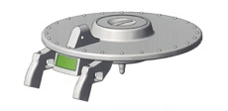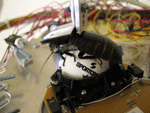

Recently, I posted about research suggesting that video games could help patients recover from strokes — and that visualizing an action would help train you to perform it. In the ensuing comments, Bram pointed out that some jugglers use juggling-visualization software to mentally train. And that prompted longtime Collision Detection reader Brian Corcoran to email me with a flood of fascinating information about Claude Shannon’s juggling robots.
Who, pray tell, is Claude Shannon? Why, he’s only the inventor of modern information theory and the idea of using bits to solve complex boolean-logic problems — and, thus, he was a major inspiration for the modern computer. In his spare time, Shannon enjoyed juggling, and he even published a wonderful juggling theorem that set forth the relationship between the movement of the hands and the position of the balls. (By the way — there is no clear way to write that last sentence without the attendant double entendres. I tried.) Even cooler, Shannon built juggling robots! They’d drop balls onto the head of a drum, and catch them as they bounced up. Here’s a really excellent video of Shannon using one of the robots; a still from the movie is pictured above.
As it turns out, several people have followed in Shannon’s footsteps and built juggling robots. But according to an amazing 1995 Scientific American paper on the science of juggling, the robots have never quite emulated traditional human juggling — because they cannot master throw juggling, the art of tossing the balls in arcs through the air. The robots all work in other modes, as the article pointed out:
Although the bounce-juggling robots are fiendishly clever, a robot that can toss-juggle a three-ball cascade and actively correct mistakes has yet to be built. Some progress, however, has been achieved. Machines that can catch, bat and paddle balls into the air have been crafted. Engineers have also built robots that juggle in two dimensions. In the 1980s Marc D. Donner of the IBM Thomas J. Watson Research Center used a tilted, frictionless plane, similar to an air-hockey table. It was equipped with two throwing mechanisms moving on tracks along the lower edge of the table.
As Brian put it to me, one could think of juggling as “a sort of ‘physical’ Turing test for mechanical dexterity.”
(Thanks to Brian Corcoran for this one!)

According to a study by smellologist Alan R. Hirsch, grapefruit ought to be the hot new scent in women’s perfume. That’s because in a recent experiment, he found that men who were exposed them to the smell of grapefruit tended to judge the women around them to be five years younger than they actually were. As the Chicago Sun-Times reports:
In his study, 37 people, after wearing a surgical mask infused with various odors or no odor at all, were asked to estimate ages of people in 108 photos. On average, the men in the study underestimated the age of the women in the photos by five years. A later study using real people instead of pictures had similar results.
Even more amusing is the fact that “Hirsch got the idea after conducting a similar study that found that men sniffing a mixed floral scent on average believed women were 12 pounds lighter than they actually were.”
Judging by his web site, Hirsch spends an inordinate amount of time investigating which smells will get us to do the nasty. In another recent experiment, he tested the effect of various combination odors on men’s penile blood-flow. His findings? “Lavender and pumpkin pie” was the ultimate scent of passion, causing a 40% increase, while the runner-up — with an increase of 31.5% — was a subtle blend of “doughnut and black licorice”.
Doughnuts mixed with black licorice?
(Thanks to Peter Sagal for this one!)
I don’t use many smileys when I communicate on Instant Messenger. But my friend the artist El Rey has just created one I intend to use: the Robot Smiley. It is:
E]
Best. Emoticon. Ever.
(Thanks to El Rey for this one!)

Think the global-warming debate is relatively modern? Nope — in fact, back in the 19th century, major thinkers speculated wildly about global warming, with one major difference: They thought it was a totally awesome idea. In a hilarious essay in the current issue of the Village Voice, author Paul Collins tracks the history of people who actively proposed schemes to melt the polar ice caps. One read as follows:
“A jetty … extending eastward from Newfoundland across the water on the Great Banks” could divert the warm Gulf Stream upward toward the Arctic, noted The New York Times of one proposal in 1912. The man behind climate change this time was Carroll Livingston Riker, an engineering wunderkind who had already designed both the world’s first refrigerated warehouse and a dredging system that successfully cleared the Potomac River at half the cost of government estimate. Building a 200-mile-long jetty would cost $190 million—less than the cost of the Panama Canal, the Times pointed out—and it was, Riker insisted, not visionary at all. “It is exceedingly practical,” he said flatly.
Imaginations ran wild, and The Washington Post envisioned Manhattan becoming a tropical paradise: “People would be gathering oranges off the trees in Central Park, or picking cocoanuts from palms along the Battery, [and] hunting crocodiles off the Statue of Liberty.” The prospect sounded so splendid to New Yorkers that Senator William Calder tried to get $100,000 appropriated for a study of the idea.
After World War II, one big idea was to simply nuke the polar regions, as per the poster above.

Most people know that Hollywood celebrities have extremely large heads — because it helps their features stand out when they’re on TV and, to a lesser extent, the silver screen. This raises an interesting question: To what extent have our notions of beauty been engineered by the biases of media? In the New York Times today, art professor Michael J. Lewis wrote a fascinating essay explaining how the shift from black-and-white film to color movies to pixellated DVD-player and laptop screens have changed the nature of who’s considered hot. As he notes:
During Hollywood’s golden age, the 1930’s, the most admired beauties were stars like Greta Garbo, Carole Lombard and Jean Harlow. And their beauty was of a very different sort. For the intense tonal range of black and white photography favored a richly contoured face, with prominent cheekbones that cast lovely form-defining shadows. An “angular face,” as Katharine Hepburn termed her own, was particularly good at casting shadows. If her face was insufficiently angular, an actress might make it more so. Marlene Dietrich is supposed to have had her upper molars removed to put shadows under her cheekbones, a story she bitterly denied.
In describing these features, people invariably resorted to the metaphor of sculpture, and compared them to a glistening marble statue lighted dramatically from one side. The director George Cukor observed that “that extraordinary sculptural construction of lines and planes,” Joan Crawford’s face, “caught the light superbly, so that you could photograph her from any angle.”
Lewis predicts that the advent of wide-screen high-definition film and TV will produce yet another shift in our aesthetics — and could “offset today’s fondness for the overemphatic”. If you’ve ever seen a popular actor on high-def, you’ll know what he’s talking about: The resolution is so unsparingly precise that it’s like being Gulliver in the land of Brobdingnag, where every pore on the giants’ faces loomed like a monstrous crater.
Over at OnHD.tv, they have a hilarious page in which they report on the results of having watched a few dozen celebrities in high-def, and slotted them into two categories: Who looks better, and who looks worse. If they’re right, several Hollywood bigwigs are about to slip decidedly leftwards along the hot-or-not scale:
Cameron Diaz
The actress has had a terrible acne problem since high
school; her cheeks and forehead are littered with
unfortunate pockmarks. Ms. Diaz seems like a different
person in HDTV; she looks more like a Charlie than an
Angel.Brad Pitt
Like Ms. Diaz, Pitt had a terrible skin problem in his
younger years. The impact is clear in high-def. He’s
still a good-looking guy, but he doesn’t look like one
of People Magazine’s “Most Beautiful.”
Conversely, several hotties are apparently even hottier in HD, including Halle Berry, George Clooney, and Anna Kournikova. All told, this makes me wonder if high-def will create a market — and new style — of plastic surgery. Will stars, desperate to remain cute in the new medium, begin opting for increasingly aggressive and extraterrestrial forms of face-lifting? Or just slap on cosplay masks and be done with it?
This is one of my periodic “I’m working on an article” cattle-calls, to see if anyone has interesting stories to tell.
I’m working on a financial column for a men’s magazine about 401(k) retirement-savings plans — but actually, I’m mostly interested in hearing from any young guys who have, one way or another, blown their 401(k) savings. Some guys I’ve spoken to have just cashed them out and spent them when they left their jobs; others have job-hopped so frequently they’ve simply lost track of where all their bits of 401(k) are located. And some have just invested in ill-considered companies that cratered out of the market, taking their money with it.
If you fit this bill and have an amusing — or informative — story to tell, email me! I’d enjoy hearing from you.

It’s been about half an hour now, and I still can’t stop laughing since I watched “Your Knife Sucks.”
“Your Knife Sucks” is the promotional web site for a belt-buckle knife made by craftsman Greg Gillespie. The shiv is, as Gillespie boasts, “the world’s fastest knife”: Mounted on a clip on your belt buckle, it can be drawn and opened in one fluid motion of a single hand. This is actually quite a cool bit of design, and it has obvious benefits for those times when you need to quickly wield a knife — such as when you’re fishing. Or perhaps fending off a bear at a camp. Or maybe just rakin’ it good ‘n hard across the face of some flag-stomping hippie who LOOKS THE WRONG WAY at your wife.
These all seem like reasonable possibilities to Gillespie, and to drive home the superiority of his tool, he shot a little video (using RealMedia) in which he illustrates the lightning-fast draw of his knife, whipping it out and shoving it back into the holster, again and again and again, as he delivers a monologue:
First, mine opens before I move. Makes it ten times faster than yours. So if I’m standing in a river fishing and I need to cut a piece of line, I’m done — yours is still in your pocket. It also allows me to move my hand and move my knife the same as my hand moves, whether I’m opening a box, cutting a spring, or slapping a bad guy in his face and poking his eyes out — it’s all the same to me, it doesn’t matter how I move, my knife’s doing the same thing I’m doing.
It all goes downhill — or uphill, or possibly just straight on through the hill, depending on your point of view — from there. It’s kind of mesmerizing: Gillespie neatly distils the essence of loopy Guns-‘N-Ammo-subscriber paranoia, and also manages two or three times to talk about stabbing various people in the eyes, including, for some reason, Mike Tyson. More excellent yet is the moebius homoeroticism of the whole affair: The constant flourishing of a knife that seems to have been plucked straight out of his fly, his web-site text asking “How Fast Can You Whip Yours Out?”, the endless taunts about how he’ll “poke” you. Man, who directed this thing? Germaine Greer?
That said, I gotta admit, it does look like a pretty awesome knife.
(Thanks to Andrew at Panopticist for this one!)

I recently bought a bottle of Liquid Paper, to cover over some mistakes I’d made in in tax forms I was filling out. I hadn’t used any white-out in over a decade, and I wondered: Who the heck still uses this stuff? Then I realized that, of course, bureaucracies worldwide are still mostly uncomputerized, and generate vast amounts of forms every day — which means gallons and gallons of Liquid Paper are still needed. And indeed, in our age of Enronian paper-shredding, sneering corporate mendacity, and Nixonian secrecy on the part of the federal government, what could be more quintessentially modern than a bottle of fluid that helps you hide things?
So I opened up the business section of the Sunday New York Times and discovered that they, too, had recently wondered about the fate of the white-out industry. Turns out it’s growing by 2 per cent a year; not a huge amount, but not bad either. My favorite detail from the story:
An enduring drawback of correction fluid is the solvent vapor. That could be fixed, but not without damaging the psyche of faithful consumers, said Mr. McCaffrey of Liquid Paper: “People who have grown up using a product tend to equate its smell with quality, and you don’t want to change that — whether it’s crayons or correction fluid.”

Few things inspire more passion in engineering than the age-old quest to kill lots and lots of people. Thus we arrive at the ghastly little bit of business that is DREAD, a gun invented by US firearms-industry veteran Charles St. George. The DREAD consists of a circular chamber that spins metal ball bearings to lightning speed, then releases them toward its target. As the New Scientist reports:
St. George says the projectiles travel at around 300 metres per second upon release from the weapon, about the same speed as a handgun round. He claims a fully developed DREAD gun would be quieter than a conventional gun, less prone to malfunction, and could contain more ammunition.
DREAD also releases its balls in extremely rapid succession, which allows it to unleash formidable firepower against a target. Promotional material for DREAD states: “Due to its extraordinary high rate of fire capability, it delivers its bullets 8.5 millimetres apart, thereby delivering more mass to the target than any other weapon.”
The bullets arrive only 8.5 millimeters apart?? Good god. Mind you, weapons experts disagree about how well this would work: One claimed it was “outlandish” and doomed to failure, while the editor of DefenseReview.com raved about the gun’s ability to achieve “total target saturation”. All more proof of that ancient dictum: Guns don’t kill people — blinding streams of pulverizing ball bearings kill people.
(Thanks to Boing Boing for this one!)
A group of scientists have found that stroke patients who play video games get improved real-life bodily co-ordination. The researchers did their experiment with 10 patients who’d all had strokes more than a year previously — a demographic that tends to see very little further improvement. Then, as the Boston Globe reports, the scientists had the patients play virtual-reality games, with surprising results:
The patients in the study, which appeared in Thursday’s issue of the journal Stroke, all had weakness on one side of their body. Researchers randomly assigned them to a control group or a virtual reality group. The control group got no intervention while the virtual reality group used the video training for an hour a day, five days a week for more than a month. [snip]
One game simulated going up and down stairs, another let the patient go deep-sea diving with sharks and the third recreated snowboarding by simulating gliding down a narrow slope, jumping and avoiding obstacles.
The five patients who played the games improved in walking, standing and climbing steps, researchers said. Also, brain imaging done before and after the experiment indicated a reorganization of brain function after the therapy, said lead author, Sung H. You, assistant professor of physical therapy at Hampton University in Hampton, Va.
Dig it: Merely rehearsing a physical motion in your mind is enough to help heal your body! Of course, maybe this shouldn’t be so surprising. Athletes have long argued that mental rehearsal is key to prepping for real-life activity, and brain-scanners have recently found that when well-trained athletes meditate on their moves, the motor cortexes in their brains fire up in a fashion that seems indistinguishable from when they’re actually performing the act.
(Thanks to Debbie for this one!)

The idea of a self-replicating machines has long been a dream — and nightmare — of artificial-life science. It’s a dream for NASA dudes, for example, insofar as self-replicating machines would be useful for colonizing other planets: You just send a couple of ‘em to Mars in a flashlight-sized rocket, give ‘em 10 years, and they’ll eventually build a suburb. The nightmare scenario, on the other hand, is the old “grey goo” worry, wherein teensy nanomachines run amok and eat up the entire planet while trying to build infinitely versions of themselves, turning Earth into a slurry of unformed entropic crap, kind of like L.A.
Good times, either way you slice it! So I was intrigued to read the latest report in Nature about some Cornell scientists who’ve created genuinely self-replicating machines. They’re little cubes that can rotate internally, in a vaguely Rubik-like way; they can also attach to one another — and detach — via magnetism. The result is a set of borg-like cells that can form new copies of individual robotic “organisms.” The BBC reported on it, writing …
Their long-term plan is to design robots made from hundreds or thousands of identical basic modules.
These could repair themselves if parts fail, reconfigure themselves to better perform the task they have been set, or even to make extra helpers.
Do not fail to check out the super-odd video of the robots in action — duplicating themselves.
(Thanks to Erik and Bill for this one!)

Chris Anderson, the editor-in-chief of Wired magazine, has a Roomba Discovery — the latest generation of the massively popular robot vacuum cleaner. He also has kids, and he recently wrote a terrific blog entry about how his kids and the robot interact. Whenever Chris turns the Roomba loose, the kids play a game with it, desperately dashing around the room to try and pick up their toys before the robot hoovers ‘em up. That’s right: The robot vacuum cleaner not only cleans, but it goads the children into cleaning. As he writes:
The kids scurry around and pick up every last toy (it’s the tiniest Lego pieces that get eaten the fastest), then race around the room jumping over Roomba as it drives from wall to wall, randomly changing direction just often enough to make the game fun. (We’ve told them that if Roomba runs into them it will think that they’re a wall and not clean there, which may or may not be true.) Then, after 15 minutes of this, they’re bored and ready for bed.
I love the thought that our children are growing up used to having domestic robots in the house. Robots for them are slightly dim but friendly vacuum cleaners, not fearsome weapons or fantasy toys. “Robot love me,” declares the two-year-old.
That is, of course, a moment that is simultaneously heartwarming and incredibly freaky. The children are behaving precisely the way Sherry Turklee first described children interacting with Speak ‘N Spells and Merlin computerized games back in the late 70s — when they’d sit around having rather interesting conversations about whether the robots are alive, and if so, to what extent they were alive. Jean Piaget talked about his in his theory, too: He argued that children behave like little scientists, constantly developing theories about how the world works. They notice that when the wind blows, the trees move — so they decide that the movement of trees is what causes the wind to blow. They hold this hypothesis to be true until they get new data that contradicts it (like noticing the presence of wind when there are no trees around) and then they decide on a new theory.
The same thing happens with robots. A young enough child theorizes that one property of “life” is when something seems to move with an intelligence and a purpose — so a robot vacuum cleaner seems indubitably “alive.” Silly, sure — except how many times have you yelled at a car or a computer when it acts up?
Robots are, at heart, philosophical objects. When we regard them, with their weird mix of humanlike and alien behavior, we meditate on the nature of ourselves.
(Thanks to Debbie for this one!)

When New York chose the design for its Ground Zero memorial — an installation called “Reflecting Absence” — many people criticized it for being too abstract, and not reflecting the full horror of the 9/11 attack. “Reflecting Absence” is composed of two square wells, into which water flows in thin sheets off the rim. I, too, didn’t think much of the design — to say nothing of the stupidly poncy name.
But today the New York Times ran a fascinating story that has made me change my mind. It’s a piece about how one of the consultants on the project has built an enormous model of the wells in his Ontario backyard.
Why do this? Because tweaking the water is damn hard. The designers need to make sure that it flows at precisely the right intensity: If it runs too gently, it’ll become clogged by fall leaves, or get so buffeted by winds that it’ll splash all over viewers and corrode the surrounding concrete walls. Conversely, if it runs too rapidly, it’ll create a horrible din inside the echoey well. And here’s the thing: You cannot “scale” water. If you built an overly tiny model of the wells, you’d learn nothing about their full-size behavior, because the physics of water are completely different in each case. Hollywood producers have long been bedeviled by this problem; if you’re shooting a war flick and try to put little three-foot-long models of Navy ships a tank of water, the ships might look fine but the waves will look completely unreal — because gravity at that scale can’t produce deep swells.
What’s more, unless you built the model to nearly-full scale, you’ll never understand the weirdly chaotic ways that water can behave in real life. It’s incredibly strange stuff: “Water behaves in its own way,” as one designer of the designers told the Times. “You can tweak its environment but at the end of the day, you can’t change its behavior.” As the reporter went on to note:
Perhaps the most striking thing when the mock-up came into view, nestled incongruously in a suburban setting, was that the water walls were not the “thin sheets” described by the design jury that chose “Reflecting Absence” last year.
Rather, they were more like beaded curtains, with a striation that called to mind the vertical bands of the twin tower facades, dissolving in a cascade of tears.
The effect is achieved by pumping the water over small dams known as weirs. These have serrated edges that act like fingers, spaced one and a half inches apart, separating the flow into discrete channels.
Now I think the design sounds quite beautiful.

I love minimalist video games, since they prove that incredibly fun play doesn’t require elaborate 3D visuals — and, indeed, can result from very stripped-down symbolic systems. Last night I saw a terrific example of this: “Tag”, a game created by Rob Seward, a student in New York University’s Interactive Telecommunications Program. Tag is played by three people, each of whom has a tiny 5-by-7 grid of LEDs and a joystick (pictured above). Each player controls a differently-colored dot on the screen, and the goal is to play a game of tag: If you’re “it”, your dot blinks, and you have to try and chase after and touch one of the other players; then they start blinking and they’re “it”.
For such a crazily simple idea, it’s surprisingly fun. I wonder how many differently-sized grids Seward experimented with before he found that 5-by-7 was the perfect size: Not so small that it was impossible to run and hide, but not so big that it was impossible to catch someone else and tag them? You can play against the computer in a demo version of it online here, but the real fun is playing live against other people. As Hertz suggests:
The devices will be very cheap and small enough to integrate into the arm of a chair. I imagine these objects as a small diversion in a waiting room, inviting casual human-human interaction in a space where it would not otherwise exist.
Seward has also designed another video game that is, amazingly, even simpler. It’s called “Boo”, and here each player — at disparate locations, connected by the Net — has a physical button and a light. Your opponent hits his button, which triggers your light to go on; once you see it light up, your goal is to whack your button as fast as possible. Then you reverse the propositions. You play five rounds and whoever has the overall fastest reaction times wins. The strategy here would be hilariously nerve-racking: You could spend minutes (or even hours) anxiously monitoring your light, waiting for your opponent to pick his moment and light it up; then you’d have an opportunity to torture him or her with the same waiting game. Brilliant! And insane.
To my mind, “Boo” contains freaky allusions — though possibly unintentional ones — to the Cold War, when heads of state carried around nuclear buttons, waiting and watching anxiously for the other guy to attack.

Roboticists constantly argue about how to create the best guidance and collision-avoidance artificial intelligence. Artificial vision is still not all that great, and the algorithms for decision-making — i.e. how the robot chooses which direction to turn around an obstacle — can produce overly predictable behavior. So in December, Garnet Hertz presented a novel solution: A robot that is guided by a cockroach.
Hertz built a four-wheeled robot with a ping-pong ball atop, which functions like a trackball; whatever direction and speed the ball rolls, the robot moves. Then he mounted a giant Madagascar hissing cockroach on top of the ball. When the robot encounters an oncoming object, a light shines on the roach from the corresponding direction, and the roach — which dislikes light, of course — turns to avoid it. This gives the robot a roach-like movement and, hence, a roach-like intelligence.
He’s got a terrific web site showing how it works, but my favorite part is where he addresses the ethics of roach guidance systems:
Is the cockroach in pain?
Madagascan Hissing Cockroaches make a loud “alert hiss” when they are angry. They also enjoy feel safe when crammed into a tight space. Their cuticle has no nerve endings in it. Because of these reasons, and because they do not illustrate a fearful hiss when controlling the robot, it is my opinion that they are in no pain, and do not mind being in the robot system.It looks like the cockroach is being crushed when it is controlling the robot — is this so?
No. If you get down to the eye level of the insect, you can see that the foot-to-ground relationship of the cockroach to the trackball is very similar to a standard cockroach gait. That is, if you know what a standard cockroach gait looks like. And another thing: cockroaches appear to feel comforted and safe when they are slightly crushed. The native habitat of Madagascan Hissing Cockroaches is the forest floor; as a result, cramming underneath an object/leaf is an instinctively safe place. People tend to like open spaces, cockroaches tend to like confined spaces.

“Whiskey is for drinking. Water is for fighting over.” Such is the tagline to Watershed — a new blog started by my friend Morgan Noel, devoted to news and analysis of the politics, science, aesthetics, and sheer weirdness of water! Wars have been fought over the stuff, so he’s going to have plenty of material; indeed, given the rate at which global warming is promising to change global patterns of waterflow, we may soon be getting rather more water-related news than we’d prefer.
Apropos of that last point, if you’d like add a dash of apocalyptic despair to your morning coffee, you could get one of these “Global Warming Vanishing Land” mugs, which Morgan blogged about yesterday. From the description on the mug’s web site:
Each mug is covered with a map of the world. When you pour in a hot beverage, the mug shows what happens when the world heats up and the oceans begin to rise… Land mass disappears before your very eyes!
WATCH Florida get swallowed by the Atlantic.
SEE valuable California waterfront property turn into a modern-day Atlantis.
WITNESS Central America dissolving into a few, small islands.
Good to the last drop!
(Thanks to Morgan for this one!)
No comment necessary — this just made me smile. A Boing Boing reader sent in this piece of dialogue, overheard on a Manhattan 1 train:
Dumb teen:
Hey, look at this! It says “Train for jobs in beeyotch.”
Smarter teen:
Fool! That word is biotech. Why you gotta be ignorant all your life?

Tech pundits love to coo over how fast tha kidz these days are at typing SMS messages, how these thumb-tribe teens live in the future, how one day we’ll all evolve such mad skillz, etcetera etcetera. I myself text extensively, and can manage about 15 to 20 words per minute. But an Australian museum recently decided to run a hilarious speed trial — betweeen a bunch of teenagers using SMS, and a 93-year-old telegraph operator using Morse Code and an old-school telegraph lever. Who could send a message faster?
Heh. The nonagenarian handed the teenagers their asses. As 160 Characters reports:
He easily defeated his 13-year-old rival, Brittany Devlin, who was armed with a mobile phone and a rich vocabulary of text message shorthand. Mr Hill, whose messages were transcribed by another telegraph veteran, Jack Gibson, 82, then repeated the feat against three other children and teenagers with mobile phones.
It read: “Hey, girlfriend, you can text all your best pals to tell them where you are going and what you are wearing.”
While the telegraphist tapped out the line in full, to be deciphered by Mr Gibson, Miss Devlin employed text slang to save time. She keyed: “hey gf u can txt ur best pals 2 tel them wot u r doing, where ur going and wot u r wearing.”
Just 90 seconds after Mr Hill began transmitting, Mr Gibson announced that he had the message received and written down correctly. It took another 18 seconds for Miss Devlin’s message to reach the mobile phone belonging to her friend.
Okay, now I want some geek to invent a Morse code add-on for SMS — so I can send Morse messages from phone to phone. Wouldn’t that make for the most awesome phone in the world? A big color screen, but only one single button in the center of the keypad, that you use to enter everything: Texts, names, and numbers to call.
(Thanks to Morgan for this one!)

What do you get if you cross Wikipedia with Google and Dodgeball? Well, you get the world’s geekiest question, for one thing. But you also get Cellphedia — “the first ubiquitous social encyclopedia”, as it’s billed. The creation of the New York University student Limor Garcia, Cellphedia works like this: When you’re on the road and have a question, you fire out an SMS to the corresponding Cellphedia topic group — such as “art”, “entertainment, or “politics”. That SMS goes out to anyone who has signed on to Cellphedia and selected those areas as their interests. Then anyone who has an answer to your question SMSes it back, and voila: An instant, highly distributed, totally portable knowledge base. (And, I might add, an incredibly cool way to cheat on exams.)
The site lists some current examples of questions and answers flowing over Cellphedia, such as:
name new lebanon p.minister — najib mikati
prince williams age — 22
andy warhol died — feb 22 1987
what is ad hoc — latin for: “to a specific end or purpose”
bkln bridge length — 6016ft
age new pope — 78
what’s a phreak —- a phreak is someone who is highly skilled in the use of phone systems. phreaks are considered a subset of hackers.
who painted those big waterlily paintings — monet
mileage milwauke to ny — 879miles 12 hours 45 mins
What’s interesting here is that while some of the replies are off-the-cuff knowledge — such as the reply to “what is a phreak” — others include highly specific information (i.e. the length of the Brooklyn Bridge) that suggests the replier is sitting at their computer and Googling the answer. It reminds of an “answer service” I once thought of, where if you desperately needed some information — but weren’t near a computer — you could call a 1-900 number and, for a minor fee, have someone quickly answer your question using Google or any number of other online resources. In fact, before I got my Sidekick, when I was travelling I used to regularly call friends at work to Google stuff for me.
(Thanks to Tom for this one!)
I’m coming to this one late — several folks pointed this out to me last Sunday — but it’s worth noting for the record: A couple of salmon fishers offshore in British Columbia have caught the first Humboldt squid in Northern waters. This is all part of a migration of giant squid northwards, which is deeply freaking out the global-warming people, since these beasts aren’t supposed to thrive in colder climes. By the way, what’s so special about a Humboldt squid? Glad you asked! As the Globe and Mail reports:
Some descriptions from witnesses sound like the plot to a horror movie — water roiling with tentacles; otherworldly creatures suddenly launching into the air from beneath the surface; nightfall bringing to the surface vicious predators that slip back into the depths at daybreak, like vampires of the sea.
A Humboldt squid can grow to the size and weight of a hockey player. So, imagine Todd Bertuzzi with bulging eyes, eight arms, two tentacles, three hearts, a beak for a mouth, a brain wrapped around his esophagus and gullet with a willingness — nay, eagerness — to dine on his own kind every other meal, and you get a sense of how the squid has earned such a fearsome reputation.
There are few occasions upon which newspapers bring out prose more purple than when they attempt to describe killer squid.
(Thanks to Bret and Susan for this one!)

When NASA launched the Voyager 1 probe 26 years ago, the scientists placed a few recordings onboard — including greetings in 55 languages, a message from President Jimmy Carter, and Chuck Berry’s “Johnny B. Goode” — in case aliens ever intercepted it. Now for a mere $3.99 per minute, you can use a new service, TalkToAliens.com, to send your own personal message to our alien benefactors!
Call 1-900-226-0300, speak your mind, and it will be transmitted into the howling aether by a 10.5-foot parabolic antenna somewhere in the backwoods of Connecticut, pictured above. TalkToAliens.com broadcasts at 2.43211 GHz, which is apparently the most commonly used frequently on Earth — and thus, as the site owners claim, the one that aliens will most likely be aware of if they’re already listening in.
You can also use the service to send a text message of up to 1,000 words for $19.95. More expensive, sure, but they email you a PDF “Certificate of Interstellar Broadcast”, which is “Suitable for Framing”, and includes your name and the first 500 characters of your message.
Of course, this all raises an interesting question of cosmic etiquette: What precisely constitutes an appropriate message to send to extraterrestrials? The site offers some suggestion in its FAQ:
Q. Can I say anything I’d like in my broadcast message?
A. We strongly encourage that you refrain from any profane or indecent language. As mentioned above, it is highly unlikely that anyone here on earth will hear your messages. Even so, it would seem prudent and polite to keep your language respectable. Feel free to speak your mind, sing, chant, rant, etc. to your heart’s content. Be a good “Earth Ambassador” to any civilizations that might be tuned in!
It’s possible this is a media prank, but its total weirdness has the color of truth.
(Thanks to Erik for this one!)
I'm Clive Thompson, the author of Smarter Than You Think: How Technology is Changing Our Minds for the Better (Penguin Press). You can order the book now at Amazon, Barnes and Noble, Powells, Indiebound, or through your local bookstore! I'm also a contributing writer for the New York Times Magazine and a columnist for Wired magazine. Email is here or ping me via the antiquated form of AOL IM (pomeranian99).

ECHO
Erik Weissengruber
Vespaboy
Terri Senft
Tom Igoe
El Rey Del Art
Morgan Noel
Maura Johnston
Cori Eckert
Heather Gold
Andrew Hearst
Chris Allbritton
Bret Dawson
Michele Tepper
Sharyn November
Gail Jaitin
Barnaby Marshall
Frankly, I'd Rather Not
The Shifted Librarian
Ryan Bigge
Nick Denton
Howard Sherman's Nuggets
Serial Deviant
Ellen McDermott
Jeff Liu
Marc Kelsey
Chris Shieh
Iron Monkey
Diversions
Rob Toole
Donut Rock City
Ross Judson
Idle Words
J-Walk Blog
The Antic Muse
Tribblescape
Little Things
Jeff Heer
Abstract Dynamics
Snark Market
Plastic Bag
Sensory Impact
Incoming Signals
MemeFirst
MemoryCard
Majikthise
Ludonauts
Boing Boing
Slashdot
Atrios
Smart Mobs
Plastic
Ludology.org
The Feature
Gizmodo
game girl
Mindjack
Techdirt Wireless News
Corante Gaming blog
Corante Social Software blog
ECHO
SciTech Daily
Arts and Letters Daily
Textually.org
BlogPulse
Robots.net
Alan Reiter's Wireless Data Weblog
Brad DeLong
Viral Marketing Blog
Gameblogs
Slashdot Games